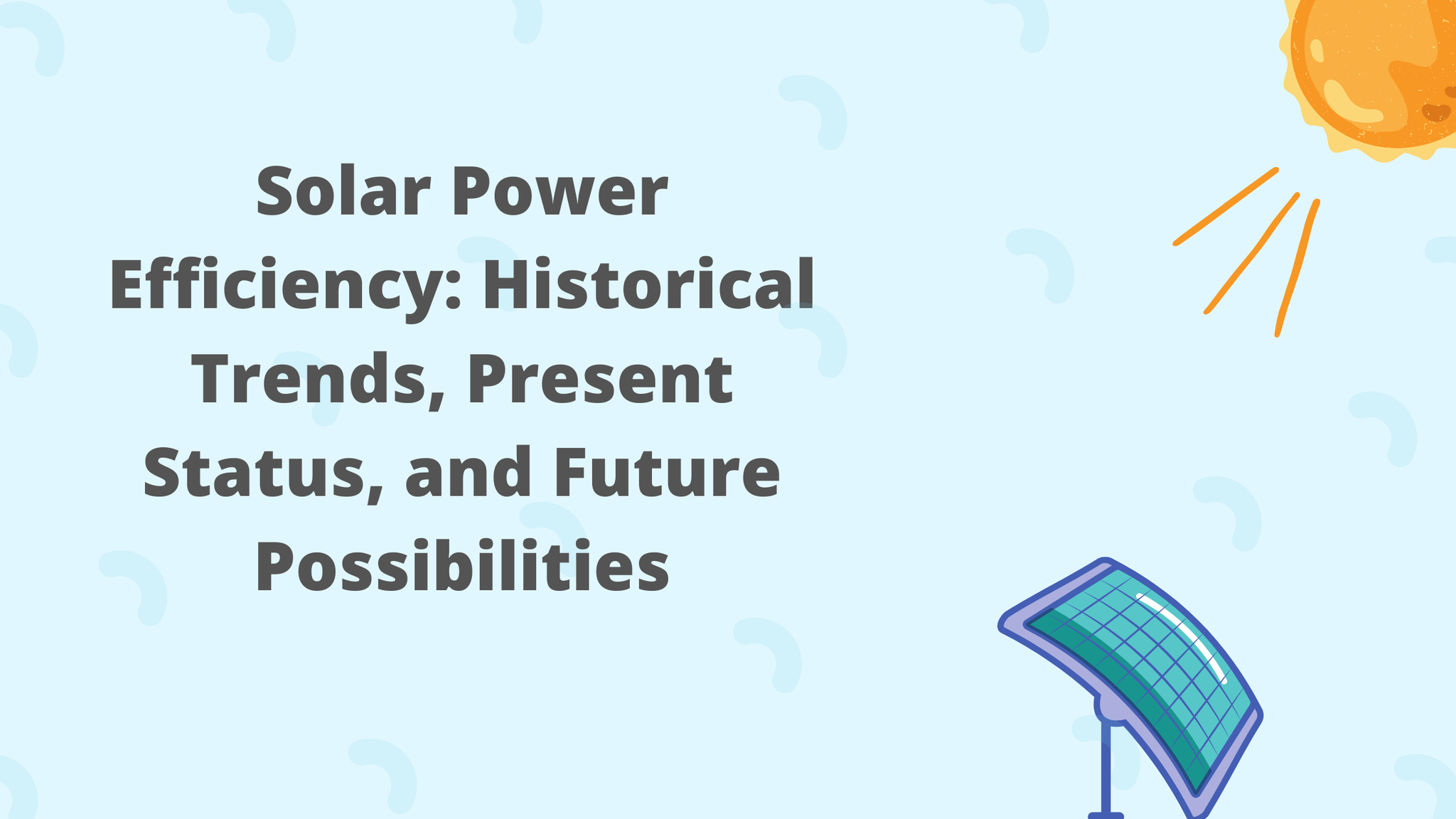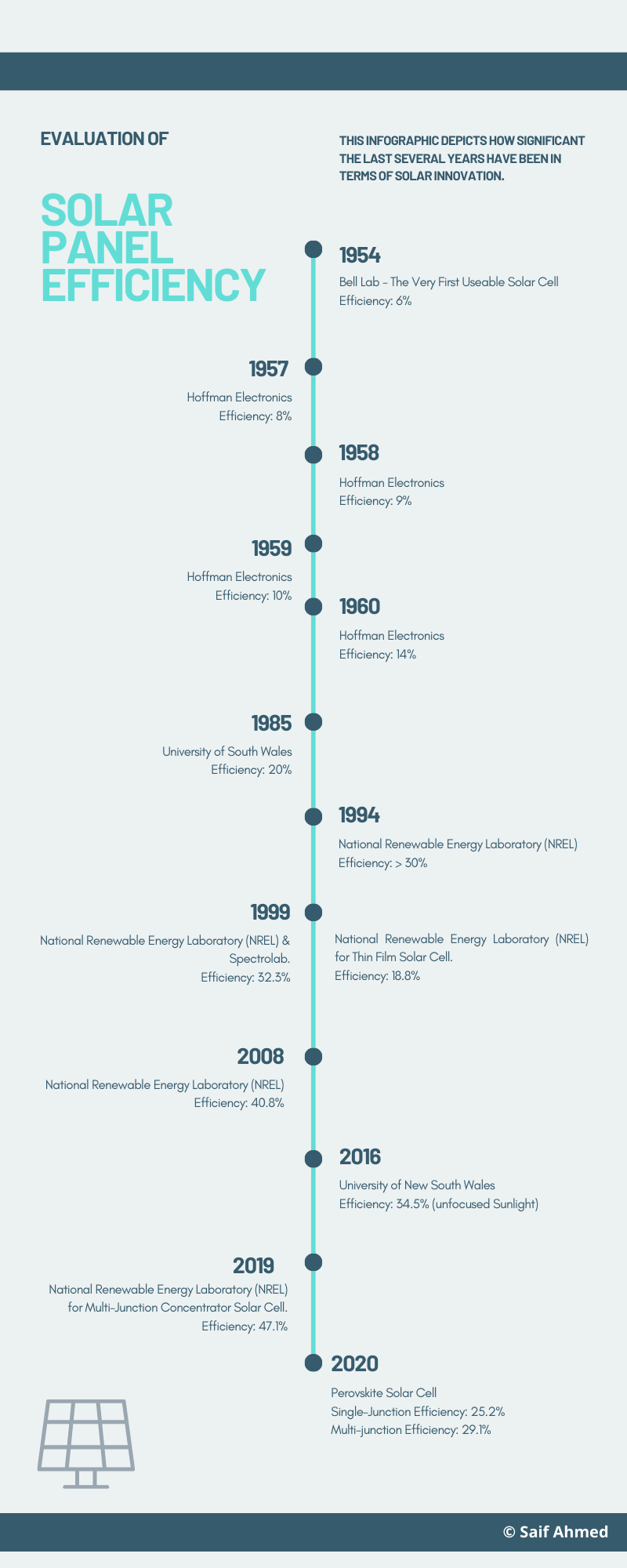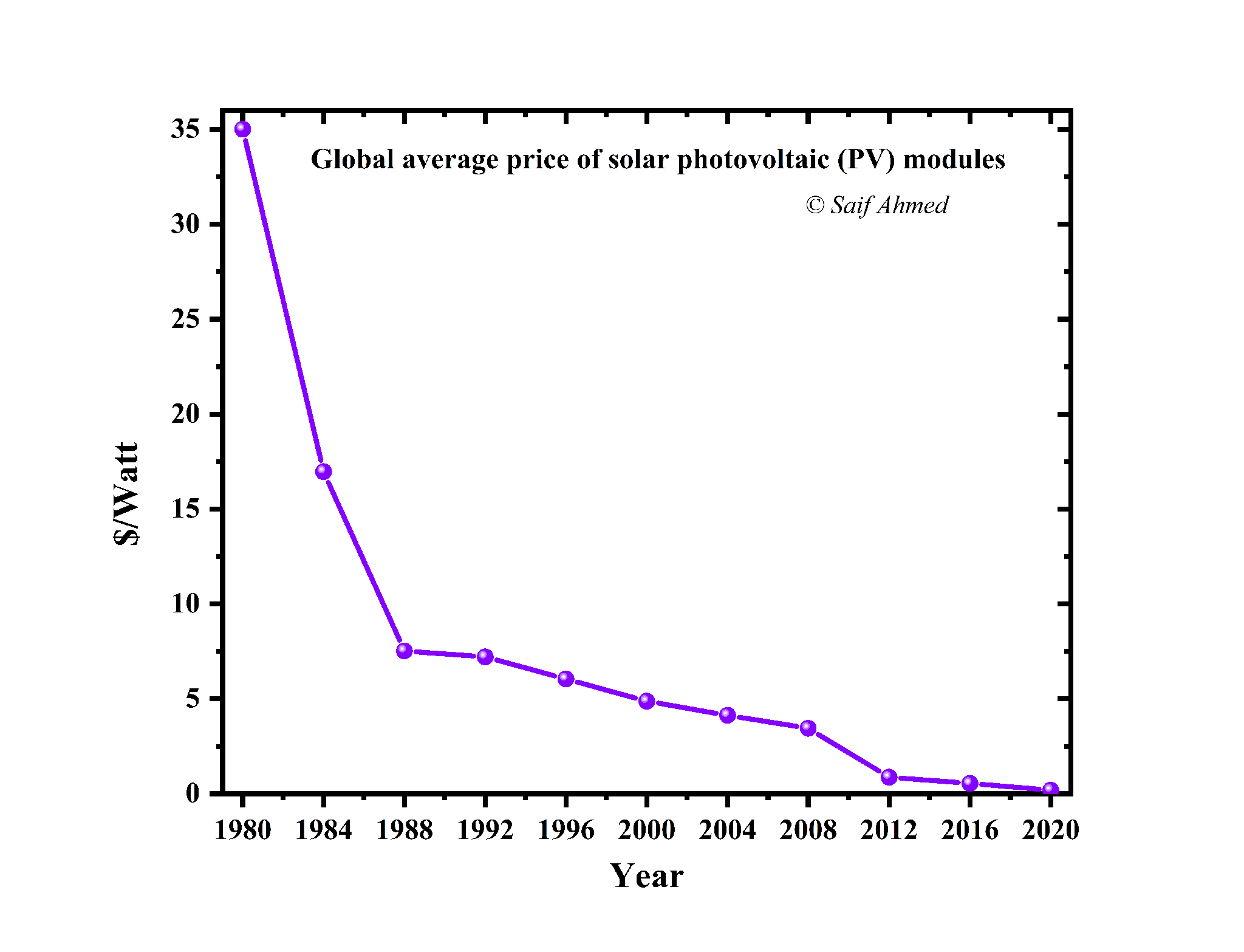Solar Power Efficiency: Historical Trends, Present Status, and Future Possibilities

The sun radiates more than enough energy to fulfill the entire world's power demands. It will not replenish like fossil fuels. Unfortunately, we are still unable to convert solar energy to electricity efficiently. Our incompetence has become a disadvantage for solar energy.
But did we attempt to increase its efficiency over time?
The very first solar cells, developed in the 1800s with selenium, were less than 1% efficient. Due to their inefficiency, they were deemed unsuitable for use as a source of energy.
The first usable solar cells were invented by Bell Labs around 65 years ago. After the invention, one key factor that accelerates the technology's advancement is the improving trend of solar panel efficiency over time. In the beginning, solar technology growth was quite sluggish. However, this technology has progressed at a breakneck speed in the last few years.
This article aims to explain the historical advancements, existing, and some possible future solar PV technologies. It is believed that these technological improvements will make our lives greener soon.
Efficiency Evolution of Solar Technology over Time
Since the beginning of history, solar technology has been evolving. Let us take a look back at the history of solar power efficiency from 1954 until the present.
1. Crystalline Silicon (c-Si) Technology
Bell Lab introduced the world to the first usable solar cells in 1954. That silicon solar panel was only 6% efficient. Hoffman Electronics achieved many breakthroughs in commercial PV technology from 1957 to 1960.
The corporation was able to enhance the efficiency rates from 8% to 14%. The University of South Wales broke the performance barrier for silicon solar cell technology in 1985 and achieved 20% efficiency. Amonix reported 27.6% efficiency for single crystal concentrator solar cells in 2005.
In 2018, the Institute for Solar Energy Research Hamelin (ISFH) attained the world's best efficiency for single crystal p-type non-concentrator silicon solar cells: 26.1%.
The best experimental power conversion efficiency of monocrystalline and polycrystalline solar cells documented until 2019 was 26.7% and 22.3%, respectively. Jinco Solar announced 23.3% efficiency for multi-crystalline silicon solar cells last year, in 2020.
According to the survey, crystalline silicon PV cells are the most widely available commercial solar panels. In 2011, it accounted for almost 85% of the global PV cell market. Currently, crystalline silicon represents more than 90% of the worldwide photovoltaic market share.
So what is motivating scientists to research new technology? Cost and efficiency trade-off in crystalline silicon solar cells! The high processing cost of crystalline silicon is compelling us to consider alternative technology.
2. Thin-film (CdTe) Technology
In 1972, Bonnet and Rabenhorst observed the first notable progress of around 6% efficiency for a CdTe technology. In 1977, Stanford University found 7.9% efficiency.
The University of Delaware introduced the first thin-film solar cell employing copper sulfide (CuS)/cadmium sulfide (CdS) in 1980. The thin-film solar cell exceeded 10% efficiency at that time.
From 1993 to 2001, thin-film technology achieved many breakthroughs. In 1993, the University of South Florida developed a thin-film solar cell using cadmium telluride (CdTe) with 15.9% efficiency. In 2001, the National Renewable Energy Laboratory (NREL) achieved a new efficiency of 16.5% for CdTe thin- films.
First Solar Inc. developed a cadmium telluride (CdTe) based thin-film solar cell with 17.3% efficiency in 2011 and 22.1% efficiency in 2016. This was a record-breaking efficiency for thin-film technology. At the end of 2020, First Solar also stated that its average commercial module efficiency is around 18%.
Today, cadmium telluride (CdTe) technology accounts for around 5% of the global solar power market. However, the toxicity of cadmium and the unavailability of telluride in nature raises questions about this technology's ability to obtain a massive solar market.
3. Thin Film (CIGS) Technology
In 1976, the University of Maine developed the very first Copper indium gallium selenide (CIGS) solar cell with an efficiency of around 4.5%. Boeing announced the first high-efficiency (9.4%) for this type of solar cell in 1981. After that, this CIGS grabbed a great deal of attention.
Thin-film (CIGS) technology had several improvements between 1995 and 2008. As per NREL, the record efficiencies of this solar cell were 17.1% in 1995, 18.8% in 1999, and 19.9% in 2008. The Swiss Federal Laboratories for Materials Science and Technology (EMPA) set a new record for CIGS cell efficiency of 20.4 percent in 2013.
In 2017, the Institute for Advanced Industrial Science and Technology (AIST) manufactured a champion CIGS solar cell with a 22.5% efficiency. Solar Frontier discovered the best efficiency of 23.4 % in 2019 for CIGS technology.
The enhanced efficiency of CIGS thin-film solar cells when compared to competing technologies are contributing to the expanding CIGS solar cells market.
However, the relatively high cost of CIGS thin-film solar cells, as well as the complexities and technicalities involved with their manufacture, may impede the growth of the worldwide CIGS thin-film solar cells market.

Future Aspects of Solar Panel Technology
Crystalline Silicon (c-Si), Copper indium gallium selenide (CIGS), and cadmium telluride (CdTe) technology have already entered the market. As previously stated, these technologies have a number of drawbacks. Although there are recommendations to resolve these disadvantages, they are difficult to put into practice. Because it will have a detrimental effect on efficiency.
As a result, research is still going on to bring new efficient technology to the industry. Some technology has the potential to replace existing commercial technologies very soon.
1. Perovskite Technology
Miyasaka and companions pioneered the use of perovskite in 2006, with a 2.2 % efficiency. In 2009, they were able to increase the efficiency to 3.8%.
Between 2012 and 2017, researchers made several advancements in perovskite technology. They broke the efficiency barrier of perovskite cells and achieved efficiency from 9.7% to more than 22%. Last year, in 2020, the efficiency of perovskite solar cells was found to be 25.5% by the Ulsan National Institute of Science and Technology (UNIST).
The rapid increase in perovskite efficiency has emerged as a real revolution. This technology has already reached the efficiency levels (roughly 25%) to be commercialized. Now researchers are working on the stability barrier of perovskite. Once this challenge is addressed, perovskite can get its commercial viability.
2. Concentrator Photovoltaic Technology
The National Renewable Energy Laboratory (NREL)-made concentrator solar cells were the first to achieve >30% efficiency using Gallium indium phosphide (GaIP) and gallium arsenide (GaAs) in 1994.
In collaboration with Spectrolab, the same laboratory found 32.3% efficiency in 1999. They incorporated three layers of photovoltaic material into a single solar cell. Boeing-Spectrolab further designed a concentrator solar cell with a world-record conversion efficiency of 40.7 percent in 2006.
In 2019, NREL overcame its limits for multi-junction concentrator solar cells by getting a maximum solar cell efficiency record, 47.1 %. Even then, the high component cost and design complexity prevent this technology from hitting the global market.
Concentrator solar cells have the highest maximum theoretical efficiency of about 86%. Having extremely high efficiency, concentrator solar technology is a potential candidate to dominate the solar market in the coming years. A slightly more focused effort on its cost can bring them to mass production.
3. Multi-junction Solar Cell Technology
In the late 1970s and early 1980s, the Research Triangle Institute and Varian Research Center were the first to create multi-junction solar cells. Sharp set a non-concentrator triple-junction solar cell efficiency record of 35.8% in 2009.
In 2013, Sharp (IIM) set a record for three-junction solar cell efficiency. They designed a three-junction non-concentrator solar cell with an efficiency of 37.9%. In 2019, NREL has overcome its limits for four-junction solar cells by getting a maximum solar cell efficiency record, 39.2 %.
Multi-junction PV technology has the most potential to change the PV industry in the long term. Although multi-junction solar cells are very efficient, their multiple material costs make commercialization problematic.
However, research on this technology is continuing. With strategic research, this technology can be commercialized.
4. Quantum-dot PV Technology
Quantum dot solar cells, the most recent technology, first appeared in 2010. The efficiency of that lead sulfide quantum dot solar cells, according to NREL, was 2.9%.
In 2014, the Massachusetts Institute of Technology (MIT) discovered that the maximum efficiency for this type of solar cell was 9%. The next year in 2015, the University of Toronto achieved an efficiency to be 9.9%
In 2017, NREL set a new global efficiency record for quantum dot solar cells, at 13.4 %. The University of Queensland achieved a new worldwide efficiency record for quantum dot solar cells in 2019, at 16.6 %.
UNIST obtained a new championship for quantum dot solar cells in 2020, with an efficiency of 18.1%.
Quantum dot solar cells are still under research. This technology has to go a long way to being commercialized due to high $/watt and low efficiency. However, adequate attention is required for success.
5. Graphene Technology
Graphene PV cells have a maximum theoretical efficiency of about 60%. The technology is still in its early development phase. On this date, it's tough to predict whether graphene will meet this high expectation or not. However, this technology is far from being commercialized. Extensive research is required on this technology.
It is clear that along with efficiency, pricing is an important factor in gaining widespread acceptability. Solar panels cost around $300 per watt when they were first introduced in 1956. From 2012 to 2020, the price has fallen from $0.88 to $0.19 per watt. And today, in 2021, installing a solar panel costs around $0.2 per watt only.
The curve below will help you realize the drastic change in cost from 1980 to the present time.

This downward trend is likely to continue in the future. Depending on Swanson’s Law, we can say, for every doubling of the global solar capacity, the price of solar PV modules will drop by nearly 20%.
Solar panel technology has come a long way from the early days of solar energy harvesting to the present. Research on possible alternatives for more efficient solar cells is ongoing and will continue in the future. This ongoing research will make solar panel technology more efficient and feasible in the coming days.
References:
- https://en.wikipedia.org/wiki/Quantum_dot_solar_cell
- https://en.wikipedia.org/wiki/Timeline_of_solar_cells
- https://www.statista.com/statistics/216791/price-for-photovoltaic-cells-and-modules/
- https://ourworldindata.org/grapher/solar-pv-prices?time=1976..2019
- https://www.adlittle.com/sites/default/files/viewpoints/ADL-Renewable-Energy-Emerging-PV-Technology.pdf
- https://www1.eere.energy.gov/solar/pdfs/solar_timeline.pdf
- https://commons.trincoll.edu/vbharam/files/2013/03/Final-Paper-Vishal-Bharam-_Silicon-in-Photovoltaic-Cell.pdf
- https://www.energy.gov/eere/solar/crystalline-silicon-photovoltaics-research
- https://www.wboc.com/story/43663386/cdte-thin-film-solar-cell-market-2021-is-estimated-to-clock-a-modest-cagr-of-167nbspduring-the-forecast-period-2021-2026-with-top-countries-data
- https://www.nrel.gov/pv/cell-efficiency.html
- https://www.energy.gov/eere/solar/cadmium-telluride
- https://news.energysage.com/solar-panel-efficiency-cost-over-time/
- https://www.researchgate.net/publication/238394778_IIIV_Multijunction_Solar_Cells_for_Concentrating_Photovoltaics
- https://solarlove.org/sharp-regains-solar-cell-efficiency-record/
- “Novel Photoelectrochemical Cell with Mesoscopic Electrodes Sensitized by Lead-halide Compounds (11),” ECS Meet. Abstr., 2008, doi: 10.1149/ma2008-02/1/27.
- A. Kojima, K. Teshima, Y. Shirai, and T. Miyasaka, “Organometal halide perovskites as visible-light sensitizers for photovoltaic cells,” J. Am. Chem. Soc., 2009, doi: 10.1021/ja809598r.
- H. S. Kim et al., “Lead iodide perovskite sensitized all-solid-state submicron thin film mesoscopic solar cell with efficiency exceeding 9%,” Sci. Rep., 2012, doi: 10.1038/srep00591.
- O. K. Simya, A. Mahaboobbatcha, and K. Balachander, “Compositional grading of CZTSSe alloy using exponential and uniform grading laws in SCAPS-ID simulation,” Superlattices Microstruct., vol. 92, pp. 285–293, 2016, doi: https://doi.org/10.1016/j.spmi.2016.02.019.
- A. Kowsar et al., “Progress in major thin-film solar cells: Growth technologies, layer materials and efficiencies,” Int. J. Renew. Energy Res., vol. 9, no. 2, pp. 579–597, 2019.
Post a comment